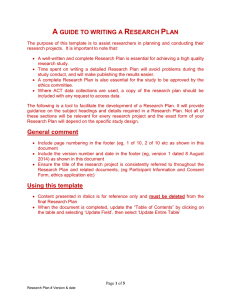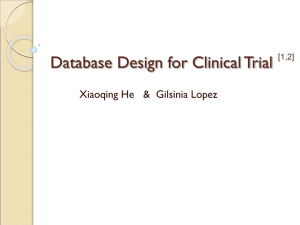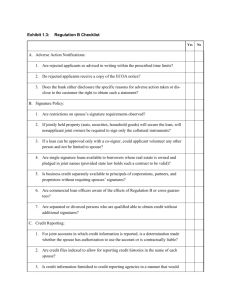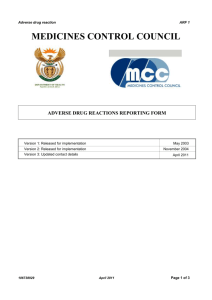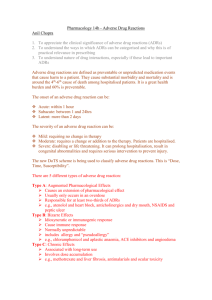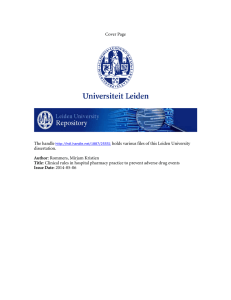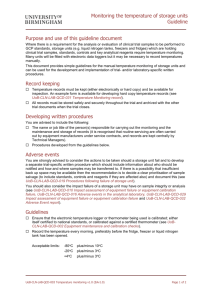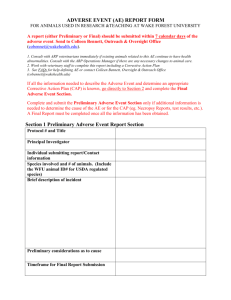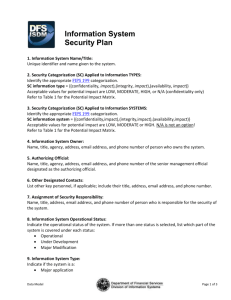Title of Research Protocol / Project
advertisement
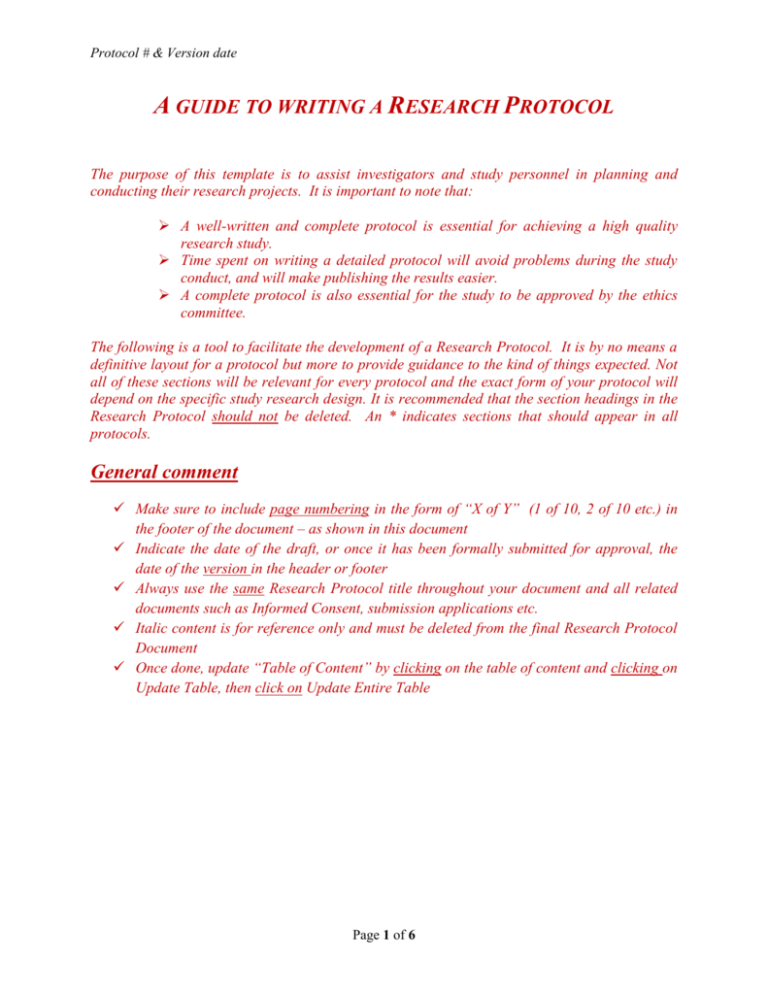
Protocol # & Version date A GUIDE TO WRITING A RESEARCH PROTOCOL The purpose of this template is to assist investigators and study personnel in planning and conducting their research projects. It is important to note that: A well-written and complete protocol is essential for achieving a high quality research study. Time spent on writing a detailed protocol will avoid problems during the study conduct, and will make publishing the results easier. A complete protocol is also essential for the study to be approved by the ethics committee. The following is a tool to facilitate the development of a Research Protocol. It is by no means a definitive layout for a protocol but more to provide guidance to the kind of things expected. Not all of these sections will be relevant for every protocol and the exact form of your protocol will depend on the specific study research design. It is recommended that the section headings in the Research Protocol should not be deleted. An * indicates sections that should appear in all protocols. General comment Make sure to include page numbering in the form of “X of Y” (1 of 10, 2 of 10 etc.) in the footer of the document – as shown in this document Indicate the date of the draft, or once it has been formally submitted for approval, the date of the version in the header or footer Always use the same Research Protocol title throughout your document and all related documents such as Informed Consent, submission applications etc. Italic content is for reference only and must be deleted from the final Research Protocol Document Once done, update “Table of Content” by clicking on the table of content and clicking on Update Table, then click on Update Entire Table Page 1 of 6 Protocol # & Version date “Title of Research Protocol / Project” Investigators & personnel Indicate the principal investigator Other investigators and /or Study Personnel and their affiliations Institution(s) responsible for the running of the study Contents 1. Synopsis................................................................................................................................................. 3 2. Abbreviations and Acronyms ................................................................................................................ 3 3. Introduction / Background * ................................................................................................................. 3 4. Objectives *........................................................................................................................................... 3 5. Study Methodology * ............................................................................................................................ 3 6. Study population ................................................................................................................................... 4 7. Study procedure * ................................................................................................................................. 4 8. Data Management * ............................................................................................................................. 4 9. Adverse Event Reporting ...................................................................................................................... 5 10. Statistical Analysis ............................................................................................................................ 5 11. Quality assurance, monitoring & safety............................................................................................ 5 12. Ethical Issues ..................................................................................................................................... 5 13. Finance and resource use* ............................................................................................................... 5 14. Dissemination of Results and Publication policy .............................................................................. 5 15. References *...................................................................................................................................... 6 16. Appendices ........................................................................................................................................ 6 Page 2 of 6 Protocol # & Version date 1. Synopsis This is similar to an abstract and should be about the same length (250-300 words). It acts as a stand alone summary of the study and should be present in large protocols. It generally consists of 1-2 sentences background then the concise objective or aim followed by a brief outline of description of participants, intervention, methods, outcome measures and proposed analysis. 2. Abbreviations and Acronyms List Abbreviations and Acronyms 3. Introduction / Background * This should include the following: Introduction to the topic of interest. What is known already - literature review of relevant findings (Brief and focused) Highlight area where there is missing information in the literature State the aims of this study– what the study is going to find out, and in one sentence how this is going to be achieved. Impact - this is where you indicate how the study will substantially add to science, change practice, save money and best of all save lives or improve quality of life in substantial numbers of people. Include an economic impact if possible. (note impact is sometimes placed at the end of the protocol) A handful of relevant references The background should not be an exhaustive literature review. At the end the reader should have a clear idea of what is the research question, an understanding that it is original and relevant, and how this research will help fill the gap in the literature. 4. Objectives * Clear statement of primary and secondary objectives of the study If relevant include a clearly defined hypothesis here 5. Study Methodology * Describe study * Type of study Where is it going to be carried out (also known as setting) Sample size calculation or justification of numbers (Should be based on previous data ) Study comparison & intervention * What interventions are you comparing? If you are doing a cohort study or survey then what are the exposures or predictors of interest? Details of the interventions – this has to be very detailed if you are planning a drug / device study. Page 3 of 6 Protocol # & Version date 6. Study population Subjects * Source of participants - where and when are you going to recruit them? How many participants? Inclusion/Exclusion criteria 7. Study procedure * Patient informed consent process, if applicable Details on how interventions are going to be delivered if applicable Who is going to deliver them? Blinding For randomized studies; how patients are going to be randomized (a simple diagram showing treatment arms is often useful here) Other details of particular ways the subject will be treated during the study independent to the specific intervention(s) (for example will other drugs not be allowed or will patient’s diet or environment be controlled) Outcome * (Note there should be only one primary outcome) What are the primary and secondary outcomes Details of the outcome measures used Data collection * What data are you going to collect, how is it collected, who collects it and when? Details of intervention data Details of outcome data Details of all demographic data and other potentially confounding data Details of safety data and adverse events Further subject follow-up, if applicable When and for what? Especially for adverse events How often? What data is collected at each time point? Study timelines: Expected duration of the study& start times, stages of the study such as screening, treatment phase (Visit numbers), etc Patients withdrawal Are there any conditions that will cause a patient to be withdrawn from the study? What happens if a patient wishes to withdraw consent? Risk / benefit 8. Data Management * Where and how is data going to be stored? Page 4 of 6 Protocol # & Version date Case record forms Database Will there be any attempts to de-identify data? Privacy and Confidentiality 9. Adverse Event Reporting Provide a definition of an Adverse Event (AEs) and Serious Adverse Event (SAEs) based on the study Include methods and timings for assessing, recording, and managing adverse events and safety parameters Also include how will you report these procedures and stopping rules for a study participant 10. Statistical Analysis Analysis plan Details on how the primary and secondary outcomes will be analysed. Statistical methods to be used Who is going to carry out the analysis? 11. Quality assurance, monitoring & safety Any external committees overseeing the study such as Study Steering Committees or Data and Safety Monitoring Committees? Will there be an interim analysis? How will adverse events be identified and acted upon? Are there any specific safety measures or is there important safety data being collected? 12. Ethical Issues 13. Have interventions been used before? What goes beyond standard practice? Identify and justify any dual relationships, coercion or inducement Identify and justify any non-negligible risk or burden Finance and resource use* Details of funding bodies Budget including direct and indirect costs 14. Dissemination of Results and Publication policy The protocol should specify not only dissemination of results in the scientific media, but also to the community and/ or the participants, and consider dissemination to the policy makers where Page 5 of 6 Protocol # & Version date relevant. Publication policy should be clearly discussed- for example who will take the lead in publication and who will be acknowledged in publications, etc. 15. References * 16. Appendices Page 6 of 6
